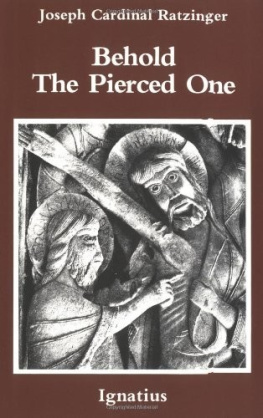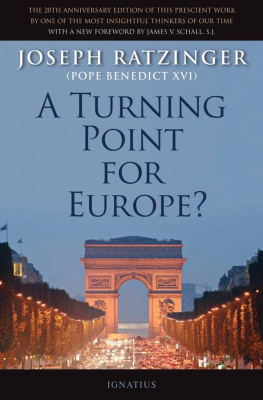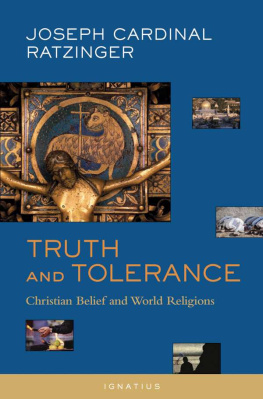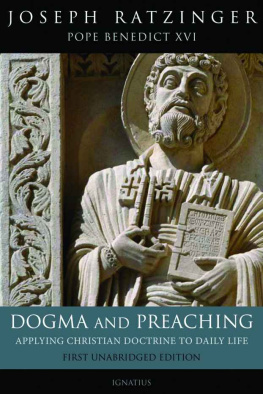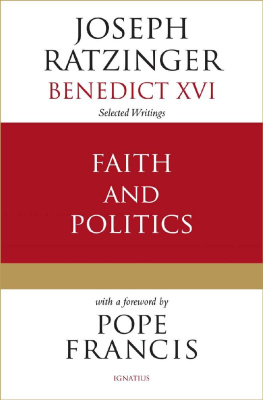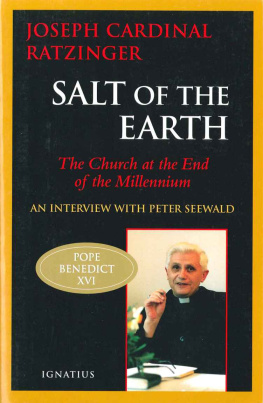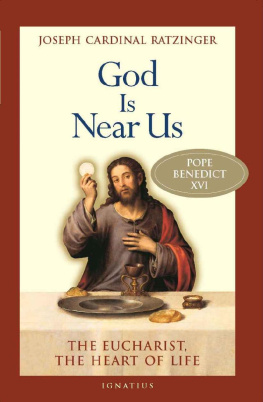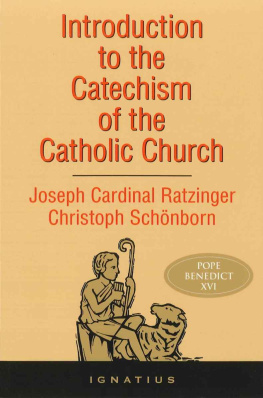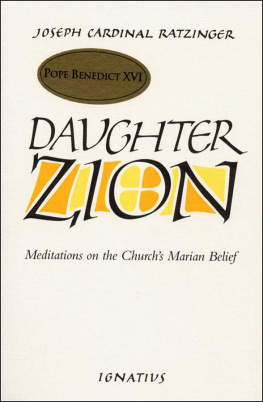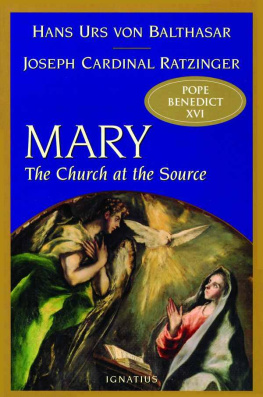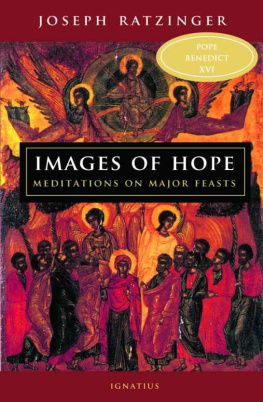Joseph Cardinal Ratzinger - Behold The Pierced One
Here you can read online Joseph Cardinal Ratzinger - Behold The Pierced One full text of the book (entire story) in english for free. Download pdf and epub, get meaning, cover and reviews about this ebook. year: 2011, publisher: Ignatius Press, genre: Religion. Description of the work, (preface) as well as reviews are available. Best literature library LitArk.com created for fans of good reading and offers a wide selection of genres:
Romance novel
Science fiction
Adventure
Detective
Science
History
Home and family
Prose
Art
Politics
Computer
Non-fiction
Religion
Business
Children
Humor
Choose a favorite category and find really read worthwhile books. Enjoy immersion in the world of imagination, feel the emotions of the characters or learn something new for yourself, make an fascinating discovery.
- Book:Behold The Pierced One
- Author:
- Publisher:Ignatius Press
- Genre:
- Year:2011
- Rating:3 / 5
- Favourites:Add to favourites
- Your mark:
- 60
- 1
- 2
- 3
- 4
- 5
Behold The Pierced One: summary, description and annotation
We offer to read an annotation, description, summary or preface (depends on what the author of the book "Behold The Pierced One" wrote himself). If you haven't found the necessary information about the book — write in the comments, we will try to find it.
Joseph Cardinal Ratzinger: author's other books
Who wrote Behold The Pierced One? Find out the surname, the name of the author of the book and a list of all author's works by series.
Behold The Pierced One — read online for free the complete book (whole text) full work
Below is the text of the book, divided by pages. System saving the place of the last page read, allows you to conveniently read the book "Behold The Pierced One" online for free, without having to search again every time where you left off. Put a bookmark, and you can go to the page where you finished reading at any time.
Font size:
Interval:
Bookmark:
Behold the Pierced One
JOSEPH CARDINAL RATZINGER
The Pierced One
An Approach to a
Spiritual Christology
Translated by
GRAHAM HARRISON
IGNATIUS PRESS SAN FRANCISCO
Title of the German original:
Schauen auf den Durchbohrten
1984 Johannes Verlag, Einsiedeln
The picture on the cover is
Christ and Thomas,
a relief from a column at
the Abbey of Santo Domingo de Silos
in northern Spain
With ecclesiastical approval
1986 Ignatius Press, San Francisco
All rights reserved
ISBN 978-89870-087-9
Library of Congress catalogue number 86-80103
Printed in the United States of America
This book is dedicated with gratitude to
FR. ALOIS GRILLMEIER
the great scholar of Christology
Contents
The Theological Basis
For a Spiritual Christology
Three Meditations
Preface
This little collection of christological meditations and reflections has two points of origin. The first was the Congress on the Sacred Heart of Jesus that was held at Toulouse in the summer of 1981 in connection with the Eucharistic Congress held earlier at Lourdes. In the quiet of the Dominican cloister in Toulouse I was able to work on my talk for the Congress, which became an impetus for me to consider Christology more from the aspect of its spiritual appropriation than I had previously done. During the same year I was unexpectedly led in the same direction by a very different event. The 1600-year commemoration of the First Ecumenical Council of Constantinople was being celebrated, as was the 1550-year anniversary of Ephesus; but, to my surprise, almost no attention was paid to the fact that the date of the Third Council of Constantinople681might also have been the occasion for a memorial. This caused me to acquaint myself more closely with the pronouncements of this Council. As I read the texts it became clear, much to my astonishment, that the achievement of a spiritual Christology had also been the Councils ultimate goal, and that it was only from this point of view that the classical formulas of Chalcedon appear in the proper perspective. I had no time to make a study of this particular theme, but the thought of a spiritual Christology remained with me and found its way into other works. It is from this perspective that the individual pieces were collected into this book, which, I admit, is more the presentation of a theme than its exposition. My heartfelt gratitude is due to Hans Urs von Balthasar, who, in connection with the Congress on the Sacred Heart of Jesus, encouraged me both patiently and persistently to attempt such a collection.
Joseph Cardinal Ratzinger
Rome, September 17, 1983
Part One
The Theological Basis
For a Spiritual Christology
Taking Bearings in Christology
Since the end of the Council the panorama of theology has changed fundamentally, not only as regards the matters debated by theologians, but also and in particular as regards the structure of theology itself. For whereas, prior to the Council, theological debate took place within a closely knit and uncontested framework, now the fundamentals themselves are widely matters of dispute. This is very evident in the case of Christology. Whereas, previously, discussion had centered on the various theories seeking to shed light on the hypostatic union or on particular questions such as Christs knowledge, now people are asking, How is the christological dogma related to the testimony of Scripture? and What is the relationship between biblical Christology, in its several phases of development, and the figure of the real historical Jesus?; To what extent is the Church an expression of the will of Jesus? In this connection it is significant that, in contemporary writing, the title Christ has largely given way to the personal name Jesus. This linguistic change reveals a spiritual process with wide implications, namely, the attempt to get behind the Churchs confession of faith and reach the purely historical figure of Jesus. He is no longer to be understood through this confession, but, as it were, in and through himself alone; and thus his achievement and his challenge are to be reinterpreted from scratch. Consequently people no longer speak of following Christ but of following Jesus: for discipleship of Christ implies the Churchs confession that Jesus is the Christ, and hence it involves a basic acknowledgment of the Church as the primary form of discipleship. Discipleship of Jesus, however, concentrates on the man Jesus who opposes all forms of authority; one of its features is a basically critical attitude to the Church, seen as a sign of its faithfulness to Jesus. This in turn goes beyond Christology and affects soteriology, which must necessarily undergo a similar transformation. Instead of salvation we find liberation taking pride of place, and the question, How is the liberating act of Jesus to be mediated? automatically adopts a critical stance over against the classical doctrine of how man becomes a partaker of grace.
This indicates something of the task which today faces a theology which understands itself as interpreting the common faith of the Church, not as reconstructing a vanished Jesus, at long last piecing together his real history. It is impossible, within the present compass, to answer all the many questions that face us at this point. That will be the task for a whole generation at least. My intention is more modest, namely, to put forward in a few theses certain fundamental characteristics of the indivisible inner unity of Jesus and Christ, Church and history.
Thesis 1: According to the testimony of Holy Scripture, the center of the life and person of Jesus is his constant communication with the Father.
Let us try to develop this idea a little further. The developing Churchlike the contemporaries of the earthly Jesussaw herself presented with the question as to who this Jesus was, Who is he? (cf. Mk 8:27-30). The answers of the people in the time of Jesus, as reported in the Gospels, reflect the attempt to find, in the arsenal of the known and nameable, categories in which to describe the figure of Jesus. We see the same in Simon Peters famous avowal, which has become part of the Churchs confession. Although Peters confession provided a fundamental orientation, regarded by believers as pointing in the right direction, the single formula, Jesus is the Christ, the Messiah was not sufficient by itself. In the first place the title Messiah had many different meanings; the argument between Jesus and Peter which concludes Peters confession clearly shows the problems connected with the word (Mk 8:31-33). The way Peters confession in Mark is developed in Luke and Matthew also clearly shows the need for explanation and clarification; what we have here is a piece of the Churchs credal history within the synoptic tradition itself.
Thus we can say that, though this basic confession of faith provided the infant Church with a nucleus around which her interpretation of Jesus could crystallize, it also opened up a wide field of further interpretations, as is evident from the wealth of additional titles, e.g., Prophet, Priest, Paraclete, Angel, Lord, Son of God, Son. In concrete terms, the struggle to arrive at a proper understanding of Christ in the primitive Church is the struggle to sift these titles of Jesus and put them in the correct perspective and order. In short, the whole process can be described as one of increasing simplification and concentration. In the end only three titles remain as the communitys valid adumbration of the mystery of Jesus: Christ, Lord and Son (of God).
Since the title Christ (Messiah) became more and more associated with the name Jesus and had little clear meaning outside a Jewish milieu; and since Lord, too, was not as clear as Son, a further concentration took place: the title Son comes in the end to be the only, comprehensive designation for Jesus. It both comprises and interprets everything else. So, finally, the Churchs confession of faith can be satisfied with this title. We find it in its ultimate form in Matthew, in Peters confession: You are the Christ, the Son of the living God (Mt 16:16). In bringing the many strands of tradition together in this one word and thus imparting an ultimate simplicity to the fundamental Christian option, the Church was not oversimplifying and reducing; in the word Son she had found that simplicity which is both profound and all-embracing. Son is a basic confession in the sense that it provides the key to interpretation, making everything else accessible and intelligible.
Next pageFont size:
Interval:
Bookmark:
Similar books «Behold The Pierced One»
Look at similar books to Behold The Pierced One. We have selected literature similar in name and meaning in the hope of providing readers with more options to find new, interesting, not yet read works.
Discussion, reviews of the book Behold The Pierced One and just readers' own opinions. Leave your comments, write what you think about the work, its meaning or the main characters. Specify what exactly you liked and what you didn't like, and why you think so.

